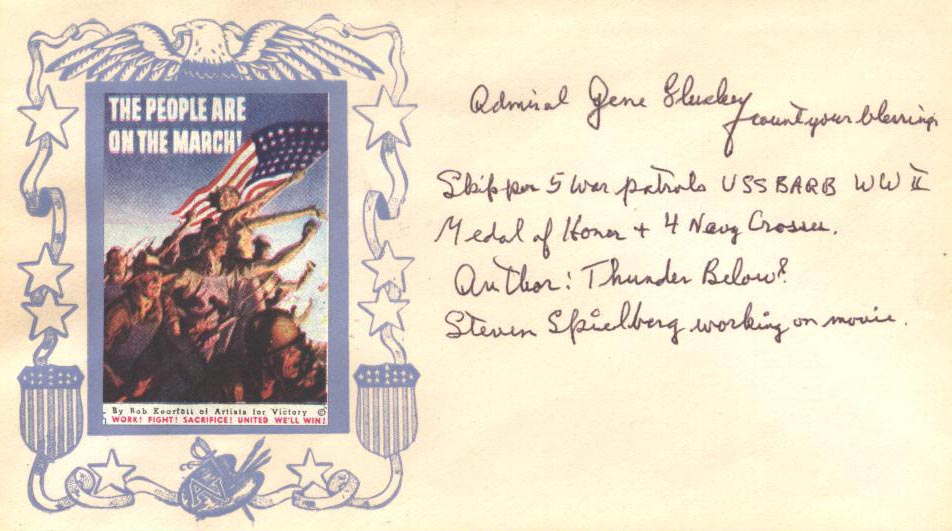
|
~SOLD~FLUCKEY, EUGENE BENNETT
Rear Admiral Eugene Bennett Fluckey (October 5, 1913 – June 28, 2007),
Fluckey was born in Washington, D.C. on October 5, 1913. He attended Western High School in Washington and Mercersburg Academy in Mercersburg, Pennsylvania. He prepared for the Naval Academy at Columbian Preparatory School, Washington. He was appointed to the United States Naval Academy in 1931, he was graduated and commissioned Ensign in June 1935.
Fluckey's initial assignments were aboard the battleship USS Nevada (BB-36) and in May 1936 was transferred to the destroyer USS McCormick (DD-223). In June 1938 he reported for instruction at the Submarine School, New London, Connecticut and upon completion, he served on USS S-42 (SS-153) and in December 1938, he was assigned to and completed five war patrols on USS Bonita (SS-165). Detached from Bonita in August 1942, he returned to Annapolis for graduate instruction in naval engineering
In November 1943, he attended the Prospective Commanding Officer's School at the Submarine Base New London, then reported to Commander Submarine Force, Pacific Fleet. After one war patrol as the prospective commanding officer of the USS Barb (SS-220), (her seventh), he assumed command of the submarine on April 27, 1944. Fluckey established himself as one of the greatest submarine skippers, credited with the most tonnage sunk by a U.S. skipper during World War II: 17 ships including a carrier, cruiser, and frigate.
In one of the stranger incidents in the war, Fluckey sent a landing party ashore to set demolition charges on a coastal railway line, destroying a 16-car train. This was the sole landing by U.S. military forces on the Japanese home islands during World War II.
Fluckey ordered that this landing party be composed of crewmen from every division on his submarine and asked for as many former Boy Scouts as possible, knowing they would have the skills to find their way in unfamiliar territory. The selected crewmen were Paul Saunders, William Hatfield, Francis Sever, Lawrence Newland, Edward Klinglesmith, James Richard, John Markuson, and William Walker. Hatfield wired the explosive charge, using a microswitch under the rails to trigger the explosion.
Fluckey was awarded the Navy Cross four times for extraordinary heroism during the eighth, ninth, tenth, and twelfth war patrols of Barb. During his famous eleventh patrol, he continued to revolutionize submarine warfare, inventing the night convoy attack from astern by joining the flank escort line. He attacked two convoys at anchor 26 miles (42 km) inside the 20 fathom (37 m) curve on the China coast, totaling more than 30 ships. With two frigates pursuing, Barb set a then-world speed record for a submarine of 23.5 knots (44 km/h) using 150% overload. For his conspicuous gallantry and intrepidity, Fluckey received the Medal of Honor. Barb received the Presidential Unit Citation for the eighth through eleventh patrols and the Navy Unit Commendation for the twelfth patrol.
His book, Thunder Below! (1992), depicts the exploits of his beloved Barb. "Though the tally shows more shells, bombs, and depth charges fired at Barb, no one received the Purple Heart and Barb came back alive, eager, and ready to fight again."
FLUCKEY, EUGENE BENNETT
Rank and organization: Commander, U.S. Navy, Commanding U.S.S. Barb. Place and date: Along coast of China, 19 December 1944 to 15 February 1945. Entered service at: Illinois. Born: 5 October 1913, Washington, D.C. Other Navy award: Navy Cross with 3 Gold Stars.
Citation:
For conspicuous gallantry and intrepidity at the risk of his life above and beyond the call of duty as commanding officer of the U.S.S. Barb during her 11th war patrol along the east coast of China from 19 December 1944 to 15 February 1945. After sinking a large enemy ammunition ship and damaging additional tonnage during a running 2-hour night battle on 8 January, Comdr. Fluckey, in an exceptional feat of brilliant deduction and bold tracking on 25 January, located a concentration of more than 30 enemy ships in the lower reaches of Nankuan Chiang (Mamkwan Harbor). Fully aware that a safe retirement would necessitate an hour's run at full speed through the uncharted, mined, and rock-obstructed waters, he bravely ordered, "Battle station--torpedoes!" In a daring penetration of the heavy enemy screen, and riding in 5 fathoms of water, he launched the Barb's last forward torpedoes at 3,000-yard range. Quickly bringing the ship's stern tubes to bear, he turned loose 4 more torpedoes into the enemy, obtaining 8 direct hits on 6 of the main targets to explode a large ammunition ship and cause inestimable damage by the resultant flying shells and other pyrotechnics. Clearing the treacherous area at high speed, he brought the Barb through to safety and 4 days later sank a large Japanese freighter to complete a record of heroic combat achievement, reflecting the highest credit upon Comdr. Fluckey, his gallant officers and men, and the U.S. Naval Service.
Signed envelope with notations all in Fluckey’s hand
Price: $0.00
Please contact us before ordering to confirm availability and shipping costs.
Buy now with your credit card
other ways to buy
|


